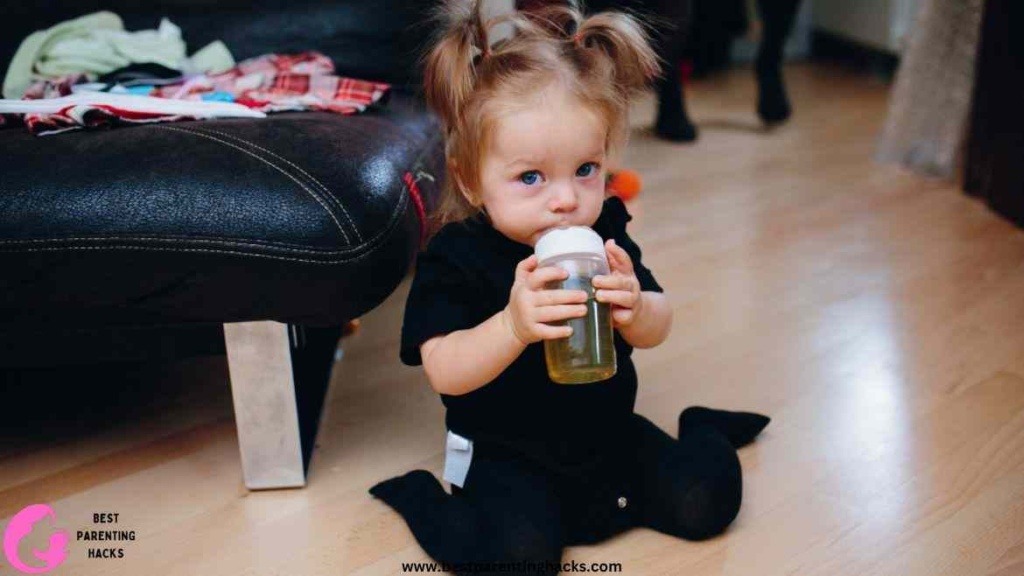Table of Contents
Getting through the early phases of parenthood has its special mix of rewards and difficulties. Feeding time is one instance where the two are interwoven. It’s a time to strengthen our relationships and make sure our children are well-fed and happy. But occasionally, this easy-to-understand chore might turn into a challenging challenge. Imagine this: your infant starts pushing the bottle away out of a sudden, and you know they are hungry. Many parents, myself included, are left perplexed by this behavior. How come a hungry baby would turn down food? Numerous caregivers throughout the world are wondering the same thing.
Although it may not be evident immediately, the solution is found in comprehending how infants express their needs and discomforts. My experience as a parent has taught me that a baby’s way of communicating with us when things aren’t quite right is through every rejection and bottle-pushing. While they may be truly hungry, there seems to be something unsettling or overwhelming about the feeding process. The secret to transforming feeding time from a struggle of wills into a calm, satisfying experience for both parent and child is to recognize and treat these underlying concerns. I’ll provide tips and tactics that have guided me and many others through these challenges and helped us raise happy, healthy, and well-fed babies in the parts that follow.

As a parent, I’ve learned that babies are extremely perceptive of their environment, much like a delicate flower in a busy city. Even while it’s a normal aspect of their growth, this sensitivity can occasionally cause children to experience what I’ve called sensory overload, which is a condition in which the daily grind becomes too much for them to handle. This excess is most noticeable during feeding times, which are supposed to be peaceful and consoling moments. Instead, they may find this to be upsetting and push the bottle away as a result of the bright lights, background noise, or even the feel of their clothing.
I’ve discovered how important it is to create a calm atmosphere. It’s about creating a bubble of calm in a society that is always buzzing, not just turning down the lights or turning down the noise. This realization inspired me to be more mindful when it comes to mealtime considering not only the act of eating but also the complete sensory experience involved.
Steps to Mitigate Sensory Overload:
1. Dim the Lights: I began by trying to create a visually calming environment during feeding times. By lowering the amount of visual stimulation that could disturb or distract my infant, I was able to create a more tranquil environment by drawing curtains or dimming the lights.
2. Minimize Background Noise: Another action I did was to lessen background noise. This required me to mute my phone, turn off the TV, and occasionally even move to a quieter room. The idea was to turn feeding times into a calm diversion from my baby’s attention-grabbing behavior.
3. Comfortable Seating: I discovered that the feeding experience was greatly influenced by my physical comfort as well as that of my infant. It helped to pick a cozy chair, use plush cushions, and make sure we were both at ease before beginning the meal.
4. Routine and Predictability: Creating a feeding schedule gave my infant an extra layer of regularity, which appeared to reassure them. They eventually started to use this ritual as a signal when it was time to eat in a secure setting.
By trial and error, I learned that treating sensory overload required more than simply fixing one area of the feeding environment—rather, it required establishing a peaceful, all-encompassing ambiance. This method not only made feeding times more enjoyable, but it also strengthened our bonding moments, transforming what used to be a stressful situation into one of our favorite parts of the day.
You Might Also Like to Read: Does Vibration Help Baby Gas?
Nipple Flow Issues: Finding the Right Fit
Finding the ideal nipple flow for my baby’s bottle is an issue that many parents encounter but rarely consider when navigating the world of newborn feeding. At first, it didn’t seem like much, but it soon became clear how important it was for the feeding experience to go well. Feeding times could become a frustrating affair for both of us if the flow rate is too rapid or too sluggish. My kid gave away very clear signs as the milk came out of the bottle; if it trickled too slowly, he would grow irritated. The key to solving this Goldilocks-like problem was figuring out the “just right” flow.
Factors to Consider for the Perfect Nipple Flow:
1. Baby’s Age and Development: I discovered that my baby’s breast flow should change as they develop. As nursing naturally occurs at a sluggish flow, newborns frequently thrive at this speed. Babies may need a quicker flow to meet their increased appetite and enhance their sucking efficiency as they get older and more adept at feeding themselves.
2. Feeding Style: It was important to pay attention to my baby’s feeding manner. Some babies struggle with a quick flow, which might cause them to cough or gulp air, while other babies, who are active feeders, might grow irritated with a slow-flowing nipple. It was all about adjusting the nipple flow to my infant’s cadence and rhythm.
3. Type of Formula or Milk: Different nipple flows may be required depending on the thickness of the milk or formula. While thinner, liquid recipes work well with slower flows, thicker formulae may require a faster flow nipple to pass through readily.
4. Baby’s Comfort and Health: Any health concerns, such as colic or reflux, had a big impact on our decision regarding nipple flow. Reduced air intake during feedings led to less discomfort and gas, which was mitigated by a slower flow.
5. Trial and Error: In the end, some experimenting was necessary to determine the ideal nipple flow. It involved attentively monitoring my baby’s responses to various flows and adjusting as necessary. Over this road, my greatest allies have been patience and attentiveness.
You Might Also Like to Read: Why is My Baby Not Babbling at 10 Months?

Teething Troubles: When Eating Becomes Painful
One of the biggest turning points in my parenting journey occurred during the teething era. It was a time of slobber and tears and, strangely, a lot of bottles shoved away. My baby’s pain was evident, transforming the once tranquil feedings into moments of annoyance and rejection. Eating had turned into a painful, or at least uncomfortable, experience, as it was communicated.
Navigating Teething and Feeding:
1. Cold Milk or Formula: I discovered that my baby’s sore gums responded well to the cold milk or formula I offered. Feeding times appeared a little easier because of the temporary relief from the discomfort that the coolness seemed to provide.
2. Teething Toys Before Feeding: It was revolutionary to introduce a cooled teething toy before feeding. Allowing my infant to chew and massage their gums before switching to a bottle, lessened the instant link between eating and discomfort.
3. Changing Feeding Schedules: During the day, a baby’s discomfort while teething may fluctuate. My infant was more open to feeding during certain times, usually in the morning or just after sleep, I noted. Maintaining a regular feeding schedule was made easier by timing feedings to coincide with these periods of less pain.
4. Gentle Gum Massage: Before and after feeding, I gave my infant a gentle massage with clean fingertips. This helped ease my baby’s discomfort and ease the transition to a bottle by acclimating his mouth to touch.
5. Consultation with a Pediatrician: Knowing when to ask for assistance was very important. My persistent unwillingness to feed prompted me to speak with our physician, who gave us advice on how to manage the pain and comforted us about this normal but difficult stage of development.
While teething is an inevitable developmental stage, feeding schedules don’t have to be disrupted. I managed to alleviate my infant’s discomfort by employing these methods making feeding manageable and less taxing for both of us.

Digestive Discomfort: Listening to Their Tummy
My baby’s feeding adventure took an unexpected turn when I began to see symptoms of stomach distress. Not only was there the unwillingness to accept the bottle but there were also the screams that seemed to be an echo of deeper agony in the aftermath. This was a blatant indication that there was more going on than teething or problems with breast flow. I realized that something was wrong with my baby’s stomach. Whether it was colic, reflux, or gas, the discomfort made feeding times difficult and drove us to look for ways to relieve my baby’s suffering and restore comfort when eating.
Addressing Digestive Discomfort:
1. Frequent Burping: During feedings, I discovered how important it is to burp my infant constantly. This was more than simply a standard procedure; it was an essential move to expel any air that was absorbed during feeding and could cause more discomfort. Feedings became more comfortable by using more frequent, moderate burping sessions, which reduced discomfort.
2. Elevated Feeding Position: It made a big difference to keep my baby more upright both during and after feeding. This posture lessened my baby’s reflux symptoms, which were contributing to his pain by preventing the milk from flowing backward.
3. Dietary alterations: We investigated dietary alterations after speaking with a doctor. This required changing my diet to stay away from items that can upset my baby’s stomach to breastfeed. Looking into various formulas made for sensitive stomachs may help newborns who are fed formula.
4. Monitoring Feeding Patterns: I began to monitor and modify feeding schedules; frequent, smaller feedings appeared to reduce pain. I concluded that overfeeding was a cause of digestive problems, and we observed improvements in my baby’s comfort levels by reducing the amount and frequency.
By making these changes and paying close attention to my baby’s signals, we were able to negotiate the tricky territory of stomach pain. It was a nudge, about how feeding and digestion are closely linked, highlighting the delicate nature of a baby’s developing system. Once I paid great attention to my baby’s needs and took thoughtful, loving action in response, we were able to resume our calm feeding routine.

Personal Experience and Observations
Getting through the early phases of motherhood has been a voyage of learning curves, mistakes, and eventually progress, particularly about feeding. Every bump in the road, from nipple flow problems to calming a teething infant, taught me more about my baby’s requirements than I ever would have thought. Beyond the doable fixes, though, this journey has been about understanding, connecting, and developing the ability to listen with my heart as well as my ears.
Key Observations:
1. Patience is Key: Patience was the first lesson. There were moments when I thought I would never be able to calm my baby down or comprehend why they wouldn’t feed. I was able to find clarity and solutions at these times when I stood back and handled the problem patiently.
2. Every Infant Is Different: I’ve learned from my experiences that what suits one infant may not suit another. It was liberating to realize this. Using an approach, allowed me to tailor my methods to suit my baby’s requirements.
3. The Power of Observation: My most useful tool turned out to be my ability to pay great attention to my baby’s indications. My kid used these cues—which were frequently subtle—to express their demands, discomforts, and preferences.
4. Seeking Support: I also discovered how critical it is to do just that. The support networks I had proved useful, whether it was talking to other parents about things like the experience or consulting a digestive specialist at the hospital. This guidance has prompted me to consider perspectives and insights on matters that were previously, beyond my contemplation.
5. Trust Your intuition: Lastly, this trip has made me realize how important it is to follow my intuition. As a parent, there were moments when I had to trust my gut feeling over all the recommendations and counsel. It led me, often, to the best choice for my child.
I hope that by sharing these discoveries I can offer comfort and reassurance to parents dealing with challenges. Recall that you are not alone on this trip, and you will overcome the challenges of feeding and beyond with perseverance, observation, and a little trial and error.

Conclusion
I’m reminded of what an amazing adventure motherhood is when I think back on my experience feeding my baby—from the first bewilderment and stress to figuring out a routine that works for us. It is a journey filled with unexpected problems, immense joy, and educational moments. The journey of feeding involved much more than just learning how to deal with nipple flow problems or handling digestive discomforts; it also taught me about resilience, adaptability, and a strong bond between a parent and his/her child that defies logic.
The value of patience, observation, and adaptability has been highlighted by this trip. It has demonstrated to me that even with the abundance of tools, techniques, and suggestions at our disposal, the most insightful realizations frequently result from paying attention to our infants and following our gut feelings. Since every infant is different, what works for one might not work for another. Approaches such as this help in dealing with feeding difficulties among several others in motherhood by accepting, enjoying, loving it, and understanding whatever comes out of such individuality.
To those parents who are starting this road or are in the middle of it, keep in mind that you are not alone. Many others have similar struggles to yours, and there is power in that commonality. With every hurdle you conquer, you’re not simply providing for your child—you’re developing a relationship unlike any other. Believe in yourself, lean on your support system, and keep in mind.
Ultimately, I trust this manual will jog your memory of the marvel and intricacy of motherhood while also aiding you in overcoming feeding challenges. May your feeding journey be brimming with rewarding and eye-opening moments.
FAQs
How should I respond if my child often rejects the bottle?
First, speak with a pediatrician to make sure there are no underlying medical conditions. Try feeding at different times, change the feeding setting to a more relaxing one, and experiment with different bottle nipples. Persistence and patience are essential.
How can I determine whether my infant is having too much sensory input while being fed?
In situations with bright lights, loud noises, or lots of activity, fussiness, crying, or turning away are indications of sensory overload. Try creating a calmer feeding environment to see if it makes a difference.
Is it true that teething will change the way my baby feeds?
Unquestionably. The painful and sensitive gums that come with teething can make it difficult to eat. It might be helpful to offer a cool teething toy before feeding and to discuss pain management techniques with your physician.
After meals, my infant seems to be gassy. How am I able to help?
A frequent way to assist in the release of trapped air during and after feedings is to burp often. To minimize air intake, you should also think about changing the way you feed as well as the kind of bottle and nipple you’re using.
How much time should pass before I decide a feeding option isn’t working?
Try any new approach or modification for at least a few days to a week to see any improvements. Your infant might need some time to get used to some modifications.




